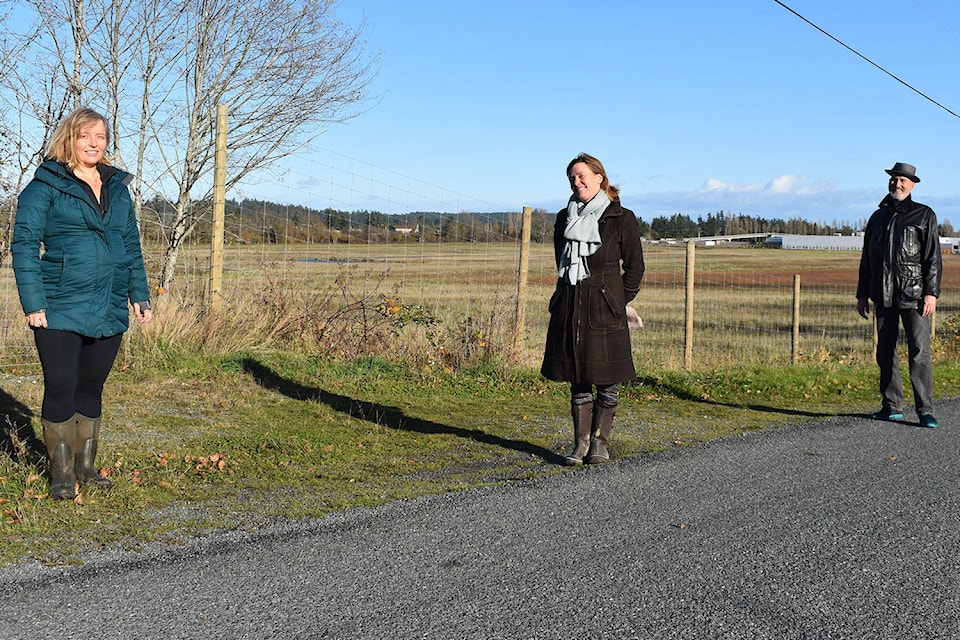Their binding signature is not yet final, but the likely future operators of the so-called Sandown Agricultural Lands in North Saanich say they are optimistic about the future of their proposed Sandown Centre for Regenerative Agriculture.
“This [project] is outside the box,” said Jen Rashleigh, director of partner and community engagement for Circular Farm and Food: Vancouver Island. “It is a fair and realistic thing to say that this is a very new undertaking for the District of North Saanich.”
North Saanich chose Circular Farm after an extensive process ahead of what can be described as a more traditional proposal from Gobind Farms. Council will consider the final agreement between the two sides on Dec. 7 and members of the public can submit feedback to by noon on Dec. 7 to be considered for inclusion in the agenda.
The two parties signed a draft agreement last month under terms that will see Circular Farm lease the former race track site from the municipality for 10 years with the municipality supplying funding for the first three years, providing $135,000 in 2020, followed by $125,000 each for 2021 and 2022, with the money expected to come from the municipality’s agricultural reserve fund. These figures are significantly lower than original requests presented earlier in the year.
Money in the fund comes from commercial taxes generated by a private development once it’s part of the site and commission from the land’s use for cellphone transmissions. “This is not at the taxpayers’ expense,” said Steve Duck, the centre’s operation manager. “It’s (to) their benefit. They are essentially re-investing something from this land back into the land. That’s huge for the municipality.” He also points to other safeguards designed to protect public investments.
RELATED: North Saanich agrees on operator, with financial support, for Sandown Agricultural Lands
Broadly, plans call for the creation of an agricultural community centre on the site featuring multiple uses and partners from the commercial, academic and non-profit sectors.
Fickle Fig Market Farm will use part of the site to graze its animals, while the University of Victoria will also use portions for academic research. Other parts of the site will produce a range of high-end crops for sale, while other parts will allow the creation of community gardens. Other parts will supply land as well as other types of support (infrastructure, industry mentorship) for aspiring farmers, or as the society calls them farmpreneurs.
Demand for this program has been high with the society having already received six applications, with the deadline for applications also Dec. 7.
Demand for this program has been high with the society having already received six applications, with the deadline for applications also Dec. 7.
“It’s a question of how much we can handle as a team and how much of the land is ready to go, because everyone knows there is a lot of the land that still needs to be actively rehabilitated,” said Rashleigh. “We don’t want to grow too fast.”
As of this writing, 10 acres of the 82 acres are ready for use. But Rashleigh notes that the society does not plan to use all of the site as it aims to rehabilitate wetlands on the site with the help of UVIC.
“If you just re-frame it, you recognize that this wetland performs an ecological, municipal function of taking care of one of our major watersheds,” said Rashleigh.
The proposed Sandown Centre for Regenerative Agriculture will not be a traditional farm, a fact that helps to explain the lengthy process and perhaps also some of the opposition, with critics questioning the very concept and its financial aspects, including the temporary financial support from the municipality.
Rashleigh understands why farmers may wonder why this project is getting support when they have not in the past. But she said if the community wants a thriving local food supply, changes are necessary, and they include improved access to land as well as other forms of support to help aspiring farmers with start up costs and diversification.
Duck acknowledged that councillors had to do a lot of thinking before agreeing to the concept. Hence, the limited financial commitment, he said.“We’ve got to find out that this works, and make sure that the community is involved as much as they can be,” he said. But Duck (like Rashleigh herself) is confident in the vision.
If everything goes according to plan, the shapes of that vision will start to emerge in the spring of 2021.
Do you have a story tip? Email: vnc.editorial@blackpress.ca.
Follow us on Twitter and Instagram, and like us on Facebook.
wolfgang.depner@peninsulanewsreview.com
